Thoughts and theories on animated works both Eastern and Western.
Don't wanna be here? Send us removal request.
Text
In light of the recent policy change...
Hello, there. As many of you know, Tumblr is now banning all adult-oriented content -- that is, any posts or blogs that contain sexually-explicit content.
Theoretically, this should not affect my analysis blog. My posts will remain online for all to see, hopefully. However, in order to show solidarity with those who will be affected by the change, I will no longer be posting new content to Tumblr.
I am deeply disappointed that platforms like Patreon and Tumblr continue to be hostile to artists and writers simply because our work is of a sexually-explicit nature. Yes, I said our -- I write erotic fiction for a living. The fact that our work is continually marginalized is both depressing and angering. There is a rightful place for us in civil society, and it’s well past time that fact was acknowledged.
I cannot, in good conscience, continue to support Tumblr by posting new content here. For the time being, my old posts will remain, but I absolutely will be moving to a new platform -- probably a personal blog of some type that no one else has any control over. I will let you know in a new post when my new blog is set up. As usual, if you need to get in touch with me, my e-mail is listed on the About page.
Thank you for being my readers. In the future, I hope to provide you with many more hours of analysis and theory discussion elsewhere.
EDIT: If you’re interested in downloading an entire Tumblr blog, there are some open-source methods. I’ve used TumblThree make a copy of my own blog, just in case. Here’s a link to the GitHub releases of TumbleThree; most Windows users will want to download the one that says “Application”.
29 notes
·
View notes
Note
I know that this is only for questions and stuff but i just wanted to tell you how baffled i am that you successfully predicted the last few episodes of season 3 and maybe even some season 4 plotpoints. Thats really imressive
Thank you very much for your kind words! I am pleased for accurately predicting that Mina would be the villain in the mid-season finale (and I got partial credit for predicting that Pony Head would get her horn ripped off by Heinous/Meteora), but other than that, most of my predictions have been way off (let’s not mention the ones about Toffee or Jeremy -- oof). Honestly, I get things wrong so often that I’d say my predictions are little more than guesswork.
But that’s one of the fascinating things about fiction – you can take things in so many different and unexpected directions. Thanks again for your comment!
8 notes
·
View notes
Note
So wow, that season finale huh? What do you think of it as a parallel to the climax of Sailor Moon S and does this affect your Holy Grail theory at all as the key item in the sailor moon climax is literally called the holy grail?
To be honest, it’s been many, many years since I watched Sailor Moon. (I was in middle school, if that gives you any indication.) I honestly can’t remember it that well, so I feel like I would be cheating if I tried to give you any sort of in-depth answer. The only thing I will say about it is that I absolutely saw a connection between what happens to Hotaru near the end of Sailor Moon S and what happens to Heinous/Meteora at the end of season three; you’re spot-on with your observation that there are some parallels.
Also: sorry it took me so long to respond to this!
3 notes
·
View notes
Note
Can you do a theory analysis about Marco cheek-marks. When I look at it, it kinda relates to the first and last quarter moons and to the Joker cards theme for him. I read some theme about meaning about the quarter moon and joker card. It represent marco's end game in season 4. Hope you not busy/lazy for this one.
Certainly, I might cover Marco’s cheek marks in a future post! That’s an interesting observation regarding the connection of the quarter moon to joker cards – I hadn’t thought of that.
3 notes
·
View notes
Text
Neon Genesis Evangelion coming to Netflix in spring 2019! Plus, Star vs. the Forces of Evil update.
As many of you may already know, my favorite anime series of all time -- Neon Genesis Evangelion -- is coming to Netflix in 2019. There’s a ton of analysis about the series already available online -- here’s a recent example. If you’ve never seen the series before, however, I would strongly recommend that you avoid reading any synopses or analyses and simply dive right into the series once it’s released (probably around April; it is the cruelest month, after all).
I first watched Evangelion in the early 2000s, back when I was still in high school. The series left an indelible impression on me, and I’ve never stopped thinking about it. Evangelion is one of the reasons I believe that animation is the superior visual storytelling medium. Film cannot possibly hope to ever replicate the heights of animation’s capability.
In celebration of the Netflix release, I will be releasing never-before-read analyses based on the series. I hope you will watch the series and follow along with me in that journey.
For those following me because of Star vs. the Forces of Evil:
Hello! It’s good to see you again. Yes, it’s been a while since I’ve written anything, but I’m still here. Mostly, I’ve been kind of down lately, but I’m still focusing on my writing -- mainly fiction writing. I’ve had some success with being published (yes, people paid me to write!), but I’m still not quite to the level that I want to be at, yet.
I haven’t written much in the way of critical analysis lately, but I’ve got a number of ideas for new topics in Star vs. the Forces of Evil. I will get to those when I can. (I have to make a living somehow, you know!) Here’s a list of potential topics I jotted down; let me know if any of these seem interesting:
Revisiting the Triple Goddess and Heinous’s shifting role from “Crone” to “Daughter”.
Unsolved mysteries of Mewni. (What is the symbolism behind pudding? Captain Blanche’s Sugar Seeds? Other weird things people have noticed? There’s a bunch of miscellaneous crap I never published!)
Glossaryck’s true nature and goals.
Star’s facility for lyric composition and its relation to her imaginative spellcasting.
The Holy Grail theory, revisited.
The betrayal of vision: the supremacy of dialogue over lip sync.
As usual, I’ve also got some other flotsam and jetsam kicking around that you can hopefully (eventually) look forward to:
A post about BoJack Horseman, probably. Even though lots of people have already said lots of good things about it.
Some thoughts on metamodernism.
The Real Ghostbusters and the perils of executive meddling.
I look forward to writing some of these. Feel free to ask me any questions you like, and look back at some of my previous analysis. Take care of yourselves!
7 notes
·
View notes
Note
This isn’t a criticism of your post in particular, but I’ve seen several people bring this up, now, and it always puzzles me that Marco’s line in “Deep Dive” about his soul being connected with Star’s is given so much credence when it clearly isn’t meant to be a valid statement in the context that it’s presented.
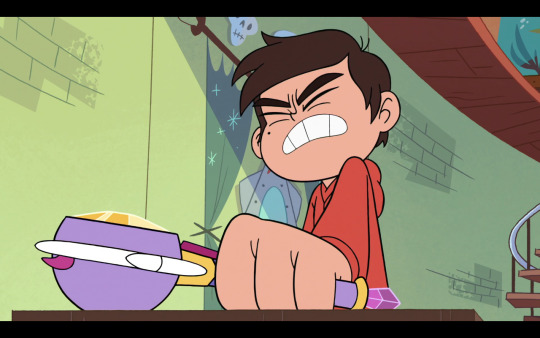
When Marco picks up the wand, he’s expecting it to change (or blow up, or something). When it doesn’t instantly change, he says, “Huh. Nothing happened. It’s like our souls are bonded –” before he’s cut off by a reaction from the wand changing.
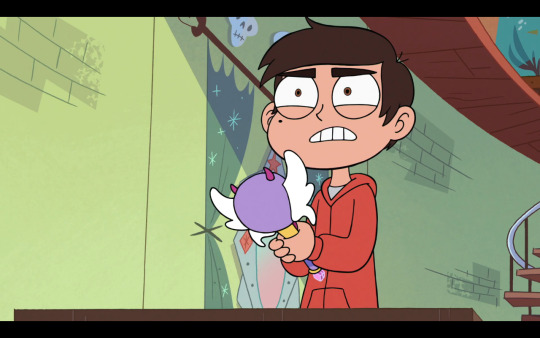
By changing, the wand proves Marco flat-out wrong; Marco is wrong because he’s attempting to explain why the wand doesn’t change. The wand obviously does change, so his line of reasoning is no longer valid.
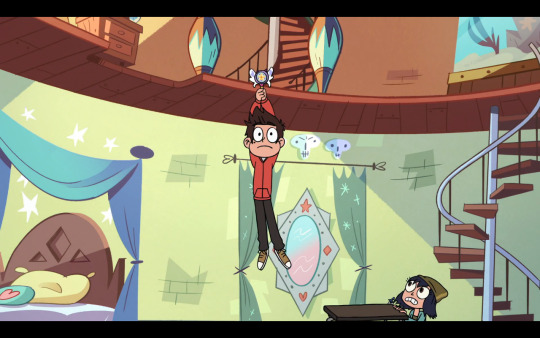
Notably, Marco offers no explanation at all for his cheek marks.
I personally agree with the far more plausible explanation of Marco’s cheek marks being due simply to him having been exposed to a sufficient amount of magic. The idea that magic is basically radiation was established in “Fetch” and reinforces this notion.
I think it’s inarguable at this point that, metaphorically speaking, Star and Marco’s souls are bonded together (for better or for worse) through their shared experiences and feelings for each other -- but is it a magical bond? It’s possible to still argue, based on what we learned in “Blood Moon Ball”, that Marco and Star are still magically bonded together -- but “Deep Dive” is decidedly not evidence in favor of that. Probably the main significance to Marco’s line in “Deep Dive” is that it shows he is aware of the depth of the bond he shares with Star, but it’s also possible that the line exists to tease the Blood Moon connection (even if it’s shown to be ultimately unrelated to Marco’s use of the wand).
That being said, I think the potential existence of a magical bond between Star and Marco that neither one controls has some pretty unsettling implications, which I hope to eventually write about in an examination of the role that fate and determinism play in Star vs. the Forces of Evil.
Hi my sister and i got the book and we stared theorizing over whats the chance marco's family may be mewman royalty since the captian photo found in his house that supposedly spoke to him(bloodmoon) and the captian that was eclipsa's father seem so similar ( we may be streaching here but it seems suspicious to us what do u think?)
Alphonse The Worthy, Eclipsa’s father, IS the sea captain seen in Blood Moon Ball! But that picture was in Star’s room, not Marco’s, and Sweet Dreams revealed that it’s part of a series of secret passages that Eclipsa used in the past, so it has nothing to do with Marco. Why it spoke to him, and if that’s going to be explained in the near future, I don’t know.
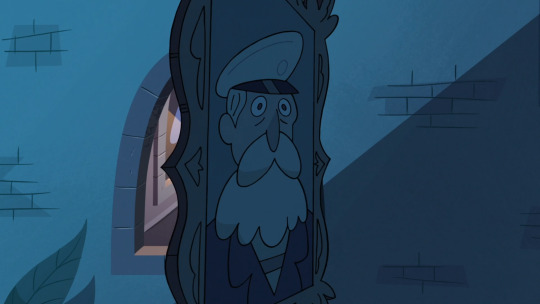
Marco’s cheekmarks might connect him to the Butterfyl family in some way, sure, but- Festivia wasn’t a real Butterfly but she developed cheekmarks due to exposure to magic- the Blood Moon bond between Star and Marco is almost certainly involved, as Marco referenced “souls being connected” just before using the wand, and it’s a much more logical explanation than a human on Earth with multi ethnic heritage being somehow related to Mewmans
79 notes
·
View notes
Note
hello! have you read Book of Spells?
I have not! I don’t have the time right now, as I’m mostly concentrating on writing fiction for a living. (And that is going well.) However, I certainly have not forgotten about this blog or about Star vs. the Forces of Evil. Nor about all of the questions that people posed to me (that are quite old by now).
7 notes
·
View notes
Text
Hello, there.
It’s been quite some time since I’ve posted, hasn’t it?
I am still alive.
Things are happening for me. You may recall that, from my last post, I have been mainly focusing on writing fiction. That labor is paying off: I will be published in print in October. (Unfortunately, I can’t say much more than that here as the subject matter is quite beyond the scope of this blog. My apologies!)
However, I have not forgotten what I have promised to post. In all honesty, it may be some time before I have enough free time and wherewithal to work on those posts. Writing paid fiction is nice (to say the least), but I also continue to consider myself a literary critic -- and, to that end, I will continue to make those types of posts on this blog.
(If I were forced to choose between the two, though, I would absolutely choose to write nothing but fiction. Writing fiction for a living has always been my dream, and it’s one that I’ve only recently felt was tangibly within reach. Besides, a man’s got to eat. I hope you understand.)
Fortunately, I need not choose; I can do both. I don’t believe my critical analysis is saleable -- I don’t make any money from this blog -- so I’ll feel perfectly happy about posting it here when I have the free time and energy to do so. This means that, yes, my analysis posts will be even slower than they were before. Sorry.
In the meantime, I would encourage you to sharpen your own craft: read, write fiction, write poetry, write analysis -- do whatever it is you do to stay connected with ideas and the skilled communication of ideas.
As usual, feel free to ask me any questions you like, and you can look back on some of my past critical analyses here. Thank you for continuing to follow this blog; I hope to return soon with something wonderful to show you. Take care of yourselves.
10 notes
·
View notes
Photo
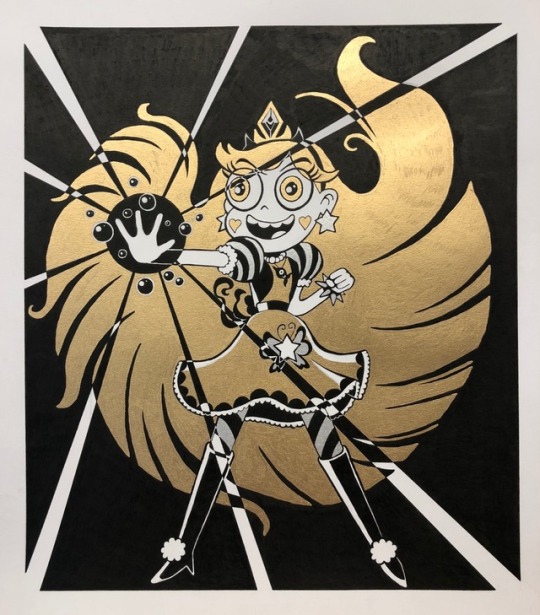
Star the Underestimated (inspired by the leaked page from the Book of Spells, plus the leaked episode segment)
546 notes
·
View notes
Link
Our Supreme Overlord is going to draw in real time for a noble cause (no, not Starco, a more important more real world one) tomorrow! Along with other two Supreme Overlords!
If you want to donate the link, as soon as active, is going to be posted HERE
125 notes
·
View notes
Photo
This cartoon will be as lousy as it is brilliant!

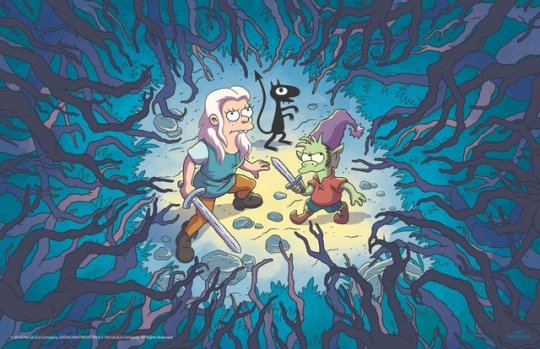
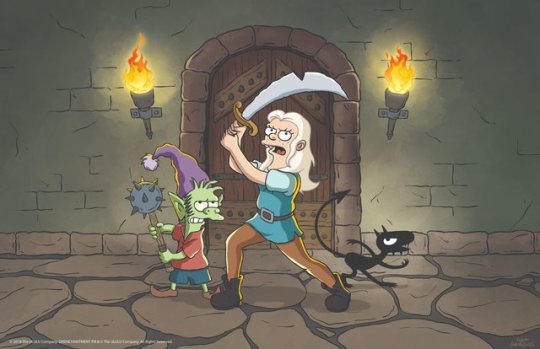
There’s gonna be a new Matt Groening show on Netflix and it looks fun. It’s called Disenchantment and I hope it’s as good as Futurama was.
9K notes
·
View notes
Text
Adam Philips has a new game! Also, “The Yuyu”.
Adam Philips, an animator whose work I have admired for quite some time, today released the game BrackenSack in early access. The game features characters known as the “dashkin” -- creatures from the mysterious Brackenwood who can travel with astonishing speed.
Many, many years ago, I was first introduced to the character known as Bitey, one such dashkin, in what remains one of my favorite animated shorts of all time, “The Yuyu” -- animated in Flash.
And, really, this post is just an excuse to link to “The Yuyu” -- so here it is:
youtube
I hope you enjoy it as much as I have.
5 notes
·
View notes
Video
I love this -- the premise, the character designs, the backgrounds. Good stuff. I expect great things from this animation.
youtube
Guess what came out today?? <3333
14K notes
·
View notes
Video
tumblr
Here’s my small contribution to this crazy episode. “Skooled” was originally boarded by Jushtin Lee and Kristen Gish, then additional boarding was done by Kenny Pittenger, Dominic Bisignano and me. Enjoy.
179 notes
·
View notes
Text
Visual language in Violet Evergarden.
Hello, there. As some of you may know, I often browse Netflix looking for animated works that interest me. For example, I recently watched The Long Long Holiday, a French animated series about two children growing up in Nazi-occupied France -- and while I certainly enjoyed watching it and would recommend it to anyone interested in the subject matter, this blog is more concerned with analysis of animated works that have a bit more texture.
What do I mean by "texture"? Texture, like a thick streak of paint on canvas, is something you can both see and feel. Animation is a visual medium. Therefore, it should not simply tell a story (although animation certainly can get by with just a well-told story -- and there are too many that fail to meet even that criterion); rather, good animation should integrate visual cues with story elements in order to express a clear idea. Visual cues include the symbolic use of color, surprising contrasts, an unusual choice of subject, the way a shot is composed, the order in which shots are placed, and so on. Animation is so expensive to produce -- why make it if you don't have a clear idea to express?
A recent series that I watched -- one that appeared on Netflix earlier this month, in fact -- is Violet Evergarden, a gorgeously-animated series from Kyoto Animation. It is based on a light novel, which I have not read; my analysis focuses entirely on the anime. In particular, I'm going to talk about the way Violet Evergarden uses visual cues. By drawing the viewer's attention to these cues, the series encourages the viewer to experience the story on multiple levels -- thus using visual language to reinforce the ideas behind the story.
If you're worried about spoilers, my analysis will only cover the first couple of episodes, and I won't go too far into plot details. Nevertheless, I've hidden the post. Continue on for the rest of the analysis.
It's easy to look at a series like Violet Evergarden and think that it's all style and no substance; apart from the eye-catching scenery, its Edwardian setting may come across as thoughtlessly chosen, and its pace can seem too leisurely aimless for some.
Don't be deceived by such appearances. There is far more going on than there seems to be at first.
The Language of Hands
Much has already been written about the series's use of the Victorian language of flowers, and that's only one example of its use of visual language and symbolism. Shots in Violet Evergarden are deliberately framed to heighten the emotional impact of what is taking place -- as they should be. In particular, shots of characters' hands are used not only to convey extra information about characters but to reinforce a theme that runs throughout the series: we can choose to use our hands to help others instead of killing them. From the very first episode, shots of hands are used to reveal information about characters, from the injured Violet and her unsteady, artificial hands to the evasive Claudia:
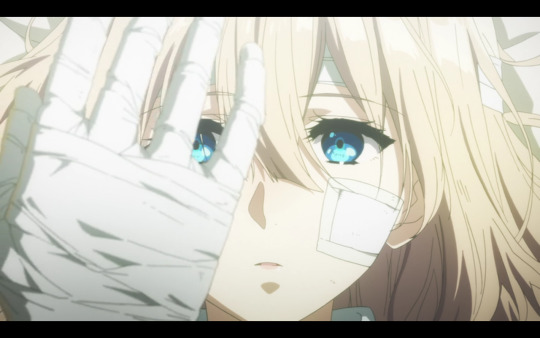
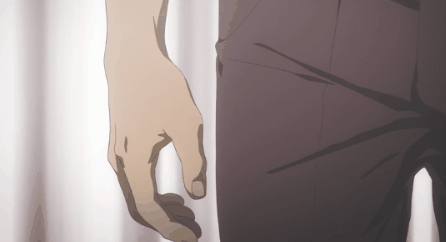
Claudia hides his hands when he lies to Violet, and our attention returns to his hands a second time to emphasize the internal tension he feels as a result of his lie; in this way, the series makes a visual connection between hands and secret feelings, a concept later brought to the forefront as Violet herself learns to connect body language to the written word. This is what I mean by visual language: by paying attention to when and how the series shows us a character's hands, we can discern more information about that character than is otherwise presented.
The series returns to this idea later as the characters address the nature of paradoxes: that is, Violet wants to work as an "Auto-Memory Doll" -- a typist who translates a client's hard-to-express feelings into a heartfelt letter -- but appears to have no understanding of her clients' emotions; despite a near-perfect grasp of vocabulary and grammar, Violet struggles with writing anything more complex than an emotionless, literal translation of what her clients have to say -- several characters liken her writing to a military report.
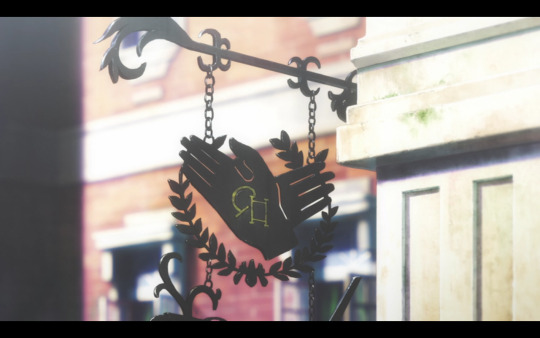
This particularly hurts her chances in the second episode. We see a vain-looking woman enter CH Postal Company -- whose symbol, not coincidentally, is a pair of hands, as if to remind us of the ultimate source of the typewritten word -- and ask Violet to write a letter to a man who wants to date her. What the woman says is that she only likes her suitor because he's rich, giving off the impression that she's mercenary and unloving -- but we're also shown important shots of her hands and legs that reveal more emotion than what the woman verbally expresses:
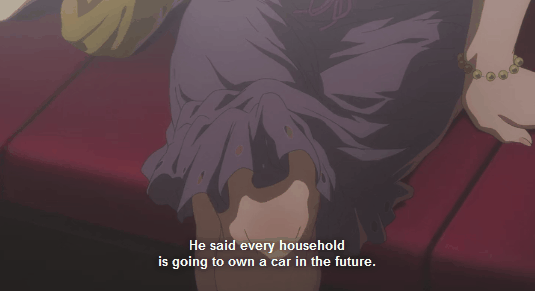
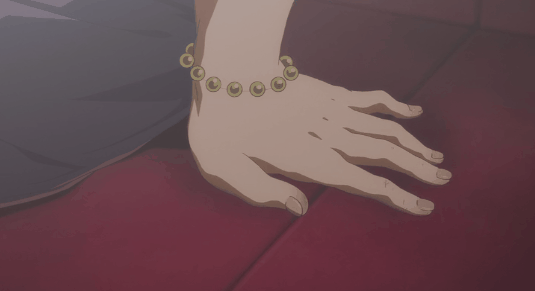
Later, when the client returns after having been rejected due to Violet’s insensitive letter, she seems genuinely distraught and reveals that, contrary to her earlier words, she truly loved the man and wanted to marry him. Had Violet paid attention to this woman's non-verbal signs -- signs which we, the audience, are invited to focus on in particular -- then she might have realized the woman's true feelings.
Violet's friends state that people are complicated to the point of being paradoxical and that the job of the Auto-Memory Doll -- that is, a writer -- is to untangle these paradoxes and resolve them into a single, heartfelt letter. There is a parallel between the characters discussing their paradoxical clients and that of visual language itself; visual language is the non-verbal communication of animation. The cleverness of Violet Evergarden is that its story elements -- Violet's inability at first to comprehend non-verbal cues -- go hand-in-hand (so to speak) with the visual cues that we the audience are given; by understanding both, we the audience are participating in the same activity of meaning-making that Violet is, which not only heightens our emotional connection to the character but also exposes us to one of the clear ideas behind the series's use of visual language: reading and writing are intimately linked to the ability to empathize with others.
Writers must understand non-verbal communication in order to best use their words; they must grasp the hidden meanings behind the words and body language of others -- discerning their disguised pain, their secret joy, the depths of their misery. They must somehow feel what another human being is feeling. In this way, writing leads to empathy.
The Heart of Violet Evergarden
The idea that reading and writing can lead to better empathy is not a new one; I've mentioned it in previous discussions about the importance of literature and critical analysis, and you can find any number of articles about it online. What I find interesting about Violet Evergarden is that it tackles this topic with one particular case study in its main character while simultaneously leading its audience through the process.
Though Violet starts off as near-emotionless -- she is often described by others as being a doll or tool -- her journey involves her slowly learning how to empathize with others, prompted by her desire to know what the words "I love you" mean and facilitated by her attempt to write letters for others. What I think is endlessly fascinating about this depiction is that Violet's quest to understand love becomes a double-edged sword: in becoming more empathetic, she understands and feels guilt as well -- guilt for her numerous killings as a soldier under Gilbert’s command.
The reality is that feeling empathy for others and understanding their thoughts and feelings makes us vulnerable; we hurt in ways that no one, not even ourselves, can salve. Yet that pain can be paradoxically transformed into a powerful call to action, as characters throughout the series, including Violet herself, demonstrate.
Thus, the letters that the Auto-Memory Dolls type are visual symbols of empathy and an acknowledgement of the semiotic nature of the written word -- that is, human beings cannot communicate brain-to-brain directly, as each individual human being is discrete and their experiences unknowable, so they must find some other way to communicate thought and feeling with one another across the gulf that exists between two minds.
Language is one way of bridging that gulf. Violet Evergarden acknowledges this function of language -- doubly so, for not only do characters communicate with each other through written letters, but the series communicates with us with its visual emphasis on the importance of where these letters originate -- at our fingertips. The series is intimately aware of the power of language and wants us to be as well.
For Now, Farewell
I hope you enjoyed this analysis. This post may have come as a surprise to those who normally read my blog for Star vs. the Forces of Evil analysis -- but rest assured that I have not yet run out of things to say about that series. I simply wanted to take a break and write about something else for a chance to refresh myself. My post on the use of irony in literature is coming soon as well, so keep an eye out for that.
I welcome suggestions of things to write about as well as any questions you may have. Some of you already have questions that I have yet to answer -- I'll get to those, but they may take a bit longer than usual due to their complexity. Please feel free to submit new ones in the meantime. Take care of yourselves.
10 notes
·
View notes
Note
You know, after this season finale, I now have a VERY strong joking headcanon that Glossaryck's real name/the 'name' he told people others call him by in the beginning (like the classic "some call me Tim" scene from Monty Python) is something along the lines of "Gosh, what a dick" and that he simply didn't care enough to correct people when they mispronounced it. What about you?
I like to think Glossaryck is a more serious character than people make him out to be, though I’m admittedly disappointed about the way his character was sidelined in season three. I particularly enjoy episodes in which he interacts with other characters, especially season two’s “Star on Wheels".
9 notes
·
View notes
